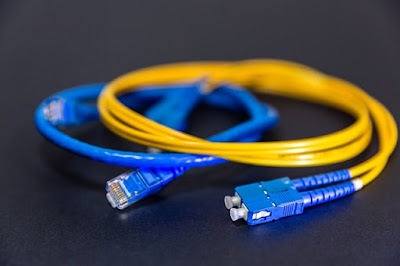What is Fiber Optic Cable ?
Fiber optic cable is a kind of cable that uses light signals to transmit data. A beam of light is transmitted from one end to another. It came as a replacement to copper wire which is known to contain many limitations in communication.
Where is Fiber Optic Cable used ?
Even some government, military and commercial businesses adopt fiber optic cables for their data transmission.
What are the types of Fiber Optic Cables ?
Based on the material on which they are made, there are two types of fiber optic cables. Those are the Plastic Optical-Fiber cables and Glass Fibers. Further according to the path the light travels, there are three types of fiber optic cables. Those are the Single mode fiber optic cable, Multimode fiber optic cable and Plastic optical fibers.
Fiber optics has gained immense popularity in the telecommunication industry due to their significant advantages. Although fiber optic cables offer many benefits over speed and bandwidth, it aren't flawless. There are several drawbacks in fiber optics too. Before implementing fiber optics technology, it is important to evaluate the pros and cons.
In this article, I will be mentioning about 5 Advantages and Disadvantages of Fiber Optic Cable | Limitations & Benefits of Fiber Optic Cable. At the end of this post, you will know the pros and cons of using fiber optic cables.
Let's get started,
Advantages of Fiber Optic Cable
1. Speed
The bandwidth offered by a fiber optic cable is extremely high compared to a copper twisted pair cable. In fact, there is no cable type in the world that provides the bandwidth as the fiber optics does. This is mainly due to the fact that it uses light as a mode of transmission. Thus, fiber optic cables are able to transmit large amount of information in a shorter time period.
2. Security
Since fiber optic cables use light as a source of transmission, there is no electromagnetic energy produced. Thus, it is almost impossible to intrude the data. This makes fiber optics the most reliable way for transmitting sensitive informations.
3. Physical Size
Comparing to a coaxial cable, the physical size of a fiber optic cable is much smaller. The diameter is not more than 2mm. This allows them to save some space where size is a primary concern. In addition to that, fiber optic cables are light weighted. As a result, they are easy to install.
4. Interference
Due to their physical properties, fiber optic cables are noise free. Meaning, electrical noises will not cause any problems to a fiber optics cable. The result of this is a much clearer phone line and internet access.
And also, fiber optic cables are resistant to electromagnetic interferences. This makes fiber optics to be used in locations where there is high electromagnetic inteferences such as high frequency towers.
5. Scalability
Fiber optic cables are made to be scalable. Which means that even if your business grows, fiber optics can be scaled accordingly to meet the needs. In the future if the network expands, additional cables and equipments can be installed allowing for quick scaling.
Disadvantages of Fiber Optic Cable
1. Installation
Installing a fiber optic cable is not an easy task because if contains some delicate components. If handled improperly during installation they are prone to breakage. Moreover, it should be installed by a person with technical expertise.
2. Integration
Merging a fiber optic cable is a difficult process. This is because there is high possibility of beam loss inside the cable. Only by a technical expert merging fiber optic cable together will be successful. They will take necessary steps to test and measure fiber optic cables.
3. Equipments
For the functioning of fiber optics technology, it requires various components besides cables. A separate transmitter and a receiver must be installed along with a repeater to boost the signal. In some instances where transmission distance tends to be long, an optical amplifier might be needed to amplify the signal.
4. Data Transmission
Propagation of light in fiber optic cable happens only in one direction. Thus, the information can only be sent unidirectional. If data needs to be moved in both ways, an additional cable needs to be deployed.
5. Physical Damages
As mentioned earlier, fiber optic cables are vulnerable to physical damages. The materials on which the fiber optic cables are made up of is glass. Glass are known to be more susceptible to damages than electrical wires.
It should not be bent too much during installation. Therefore, special care must be taken when deploying fiber optics undersea.










It's a good start for me who's just starting the course, it's indeed detailed which has made me understand what fiber optic cables are and what they do. Thanks for giving me such.
ReplyDeletesd
ReplyDeleteBecause of this component of capacitors, they are much of the time utilized in the electronic glimmer on cameras.
ReplyDelete高压陶瓷电容